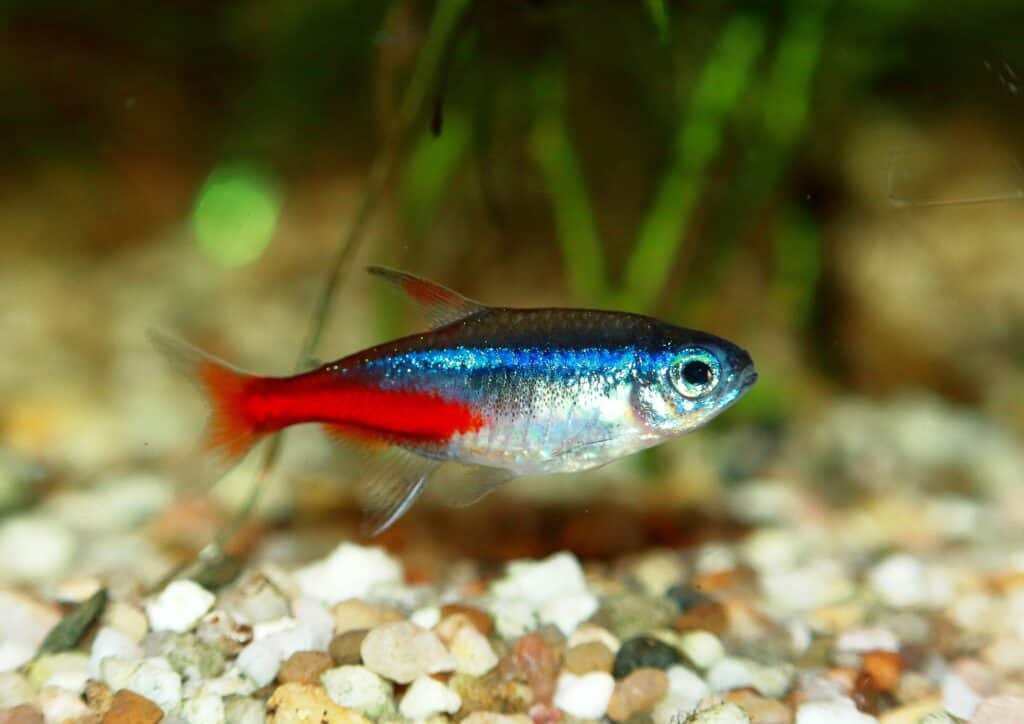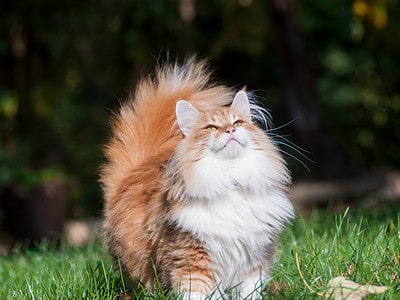Neon Tetra
Paracheirodon innesi
Neon Tetras are very social and peaceful fish.
Advertisement
Neon Tetra Scientific Classification
- Kingdom
- Animalia
- Phylum
- Chordata
- Class
- Actinopterygii
- Order
- Characiformes
- Family
- Characidae
- Genus
- Paracheirodon
- Scientific Name
- Paracheirodon innesi
Read our Complete Guide to Classification of Animals.
Neon Tetra Conservation Status
Neon Tetra Facts
- Group Behavior
- School
- Fun Fact
- Neon Tetras are very social and peaceful fish.
- Most Distinctive Feature
- Blue iridescent stripe
- Diet
- Omnivore
View all of the Neon Tetra images!
The Neon tetra (Paracheirodon innesi) is one of the most popular tropical fish in the world.
These small fish are native to clearwater and blackwater streams located in the Amazon basin in South America. This fascinating fish has a bright and reflective coloration that makes them a common choice as a pet for tropical fish keepers. You can find Neon tetras around the world in the pet trade industry where they make great additions to tropical and freshwater aquariums with their small size, hardy temperament, and attractive coloration.
Neon tetras were first imported from South America and described by ichthyologist George S. Meyers in 1936 and were given the name ‘Neon tetras’ by William T. Innes. Although Neon tetras can be found in the wild, they are commonly distributed in the pet trade industry where they are adored by aquarium hobbyists.
5 Facts About Neon Tetras
An interesting fish such as the Neon tetra is guaranteed to have many interesting facts about them!
- Neon tetras are shoaling fish that do best when kept in groups of six or more. In the wild, Neon tetras can be found in very large shoals that would be difficult and expensive to replicate in the aquarium hobby.
- Neon tetras change their coloration in response to the lighting of the environment. They can dull their vibrant colors in dark waters and reactivate their coloring in well-lit environments.
- The Neon tetra is one of the most popular tropical, freshwater fish in the world in the aquarium trade industry.
- Neon tetras are often mistaken for Cardinal tetras and these mislabeling mistakes commonly happen in pet stores. The most distinctive differences between these fish are that Cardinal tetras grow slightly larger. Since the two look so alike, it is understandable why they are often mistaken for each other.
- Neon tetras change their colors for camouflage, protection from UV radiation, and sexual selection through optical interference and chromatophore absorption on their skin cells.
Neon Tetra Classification and Scientific Name
The scientific name of the Neon Tetra is Paracheirodon innesi. The genus name consists of two parts, Para which means related to, and the genus Cheirodon. The species name, innesi, is named for the American aquarist and author William T. Innes.
Neon Tetra Appearance
The Neon tetra has a striking appearance which is what makes them one of the most popular aquarium fish in the aquarium trade. This fish has a small body and grows no larger than 1.5 inches (4 cm) and can either come in a long or short-fin variety. Neon tetras have a dark blue back with a silver belly and the blue reflects light which makes this fish appear as if it is ‘shining’.
They have a distinct iridescent blue stripe that is horizontal from their head to their nose to the adipose fin. The underside of the stripe across their body is a deep ruby color and the iridescent strip surrounds both of the fish’s eyes which are a deep black color. The Neon tetra gets its coloration from guanine crystals found inside their cells that reflect off of light.
Female Neon tetras have a slightly rounded belly in comparison to male tetras which causes the blue iridescent stripe to appear bent. Male Neon tetras have a slim body and may appear larger.
Interestingly, the Neon tetra’s color is made more vibrant during the day, but at night the color starts to fade to a grey color so that they can blend into the darkness of the water to avoid being seen by predators. When the iridescent stripe catches the light, it appears to be blue-green, whereas in the dark it will change to a deep purplish-grey color.

©Kristiana Berzina/Shutterstock.com
Neon Tetra Distribution, Population, and Habitat
Where To Find Neon Tetras
Neon tetras can be found in both the northern and western Amazon basin that is located in southeastern Colombia, Brazil, and Peru. Neon tetras are considered to be an introduced species in both the United States and Singapore; however, this fish species can be found worldwide because they are commonly kept as pets. Neon tetras are most commonly found in aquariums where they are bred and raised in captivity. This fish is imported from large breeding facilities in South America where they are imported into other countries worldwide.
Habitat
Neon tetras inhabit blackwater streams and you will not find Neon tetras in whitewater streams; however, they can be found in some clearwater streams. The Amazon basin has the perfect water conditions, which is acid and warm from 68 to 82 degrees Fahrenheit, for this fish. The Neon tetra prefers warm waters that are slightly acidic like their natural habitat, which is why it is important to try your best to replicate their natural habitat when they are being kept in captivity.
Neon Tetra Predators and Prey
The Neon tetra is an omnivore and eats both meat-based proteins and vegetative matter. In the wild, neon tetras will eat a variety of small worms, insect larvae, and algae. This fish will seek out food and forage through plants, woods, rocks, and substrate for any morsels of food.
Neon tetras prefer to be in shoals rather than alone as the shoal of fish seek safety from one another and work together to find food. Being in a large shoal also helps keep these fish secure from predators, including larger fish inhabiting the Amazon basin.
They are also considered to be prey to aquarium fish in captivity, which makes it important to keep these fish with other suitable tank mates. Neon tetras will change their coloration in response to the lighting in the surrounding environment, primarily to appear less eye-catching to predators at night.
Neon Tetra Reproduction and Lifespan
Neon tetras breed best with lots of tannins in the water, acidic water parameters, and a temperature around 75 degrees Fahrenheit. This can be difficult to replicate in captivity, however, their natural habitat produces the perfect conditions for a Neon tetra to breed.
Neon tetras can breed when they are in dim-lit environments and have a water hardness that is less than one. Neon tetras in the wild and captivity can begin breeding at 12 weeks of age, once they have reached sexual maturity. Males will seek out the females which makes it important to have a large shoal of these fish in a mixed female and male ratio if you want successful breeding behavior.
Neon Tetra Population
There is an estimate of 1.8 million Neon tetras being bred every single month after being collected from their wild habitat in Colombia, Peru, and Brazil. Many Neon tetras that you will find in pet stores today have been captured from Southeast South America and raised on fish breeding farms then sold through the aquarium trade in the United States and other continents. The majority of the Neon tetra population is found in home aquariums where they are bred experimentally by aquarium hobbyists, but commercial-scale breeding of these fish is not common in the United States.
View all 65 animals that start with NNeon Tetra FAQs (Frequently Asked Questions)
Where Are Neon Tetras Found?
Neon tetras originate from South America in the Amazon basin, however, they have become such a popular fish worldwide that they can be found in every continent where they are kept as pets. They are commonly bred in southeastern Asia and can be found in Peru, Colombia, and Brazil where they inhabit blackwater streams.
Thank you for reading! Have some feedback for us? Contact the AZ Animals editorial team.
Sources
- Wikipedia , Available here: https://en.wikipedia.org/wiki/Neon_tetra
- Aquarium Nexus , Available here: https://www.aquariumnexus.com/neon-tetras-lose-color/#
- Aquarium Source, Available here: https://www.aquariumsource.com/neon-tetra/


















